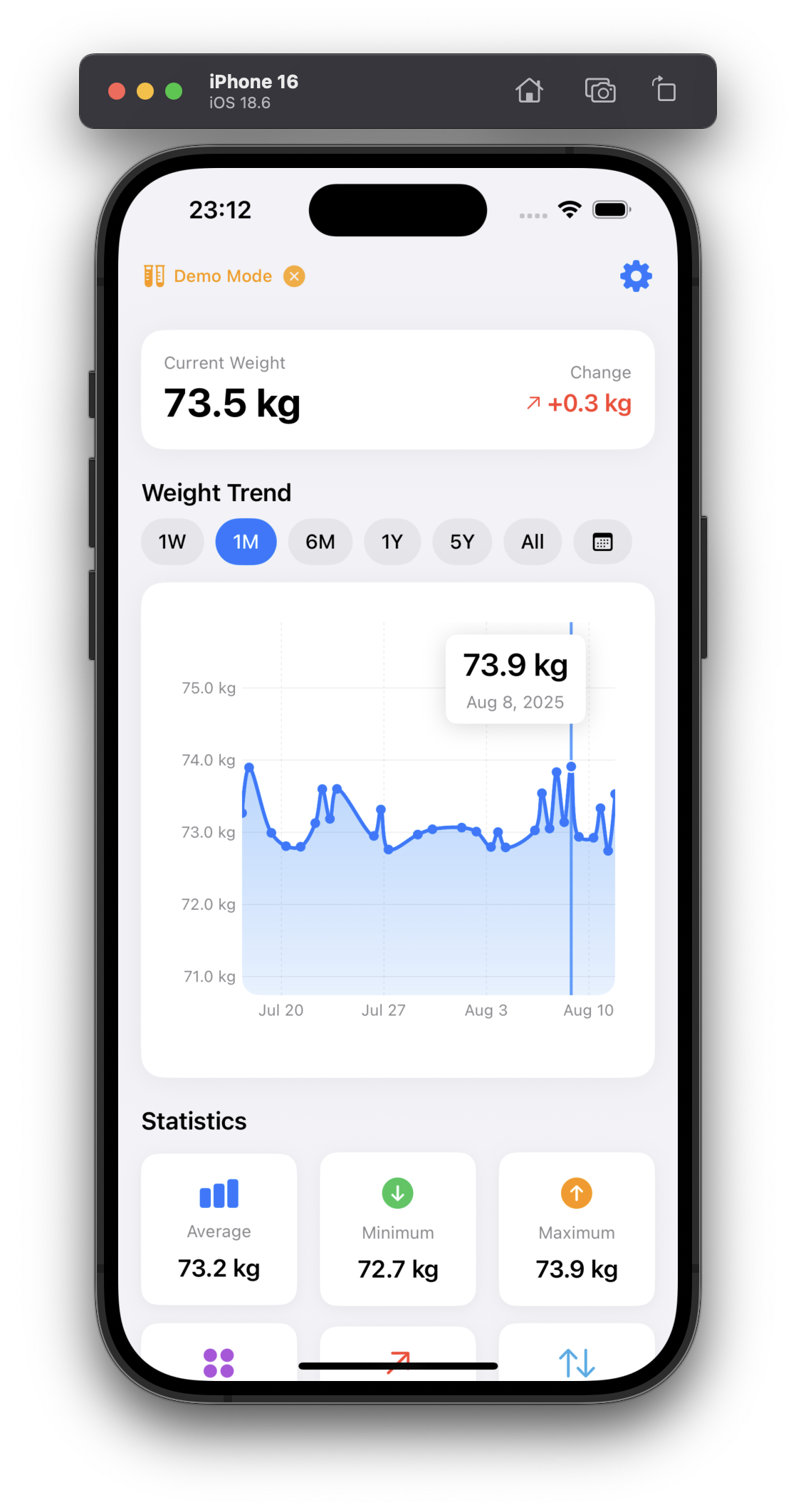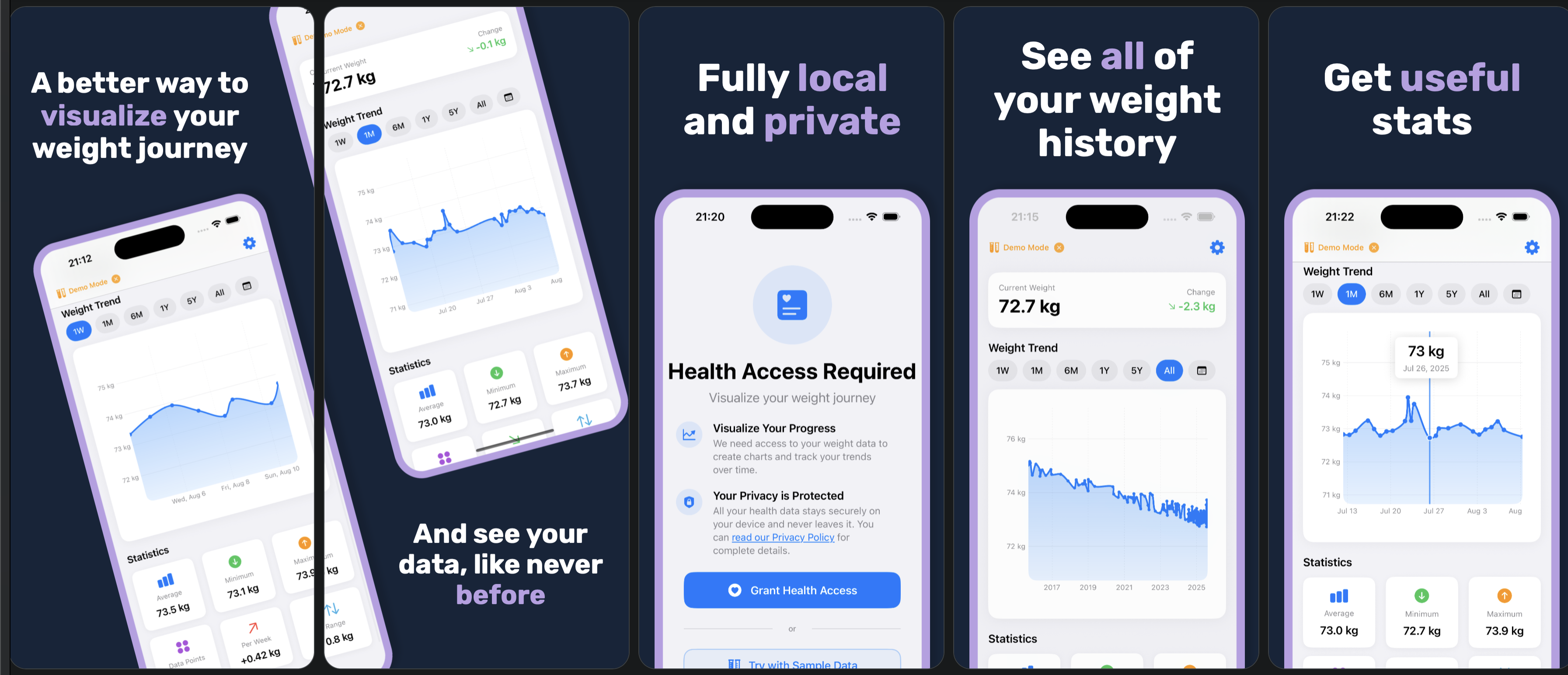Claude Coding an iOS App
I have been using Claude Code quite a bit over the past 2 months, both for side projects and at work, to varying degrees of success. I have used it for working on large legacy code bases, small greenfield code bases, TUI apps, web apps, MCP servers, just to name a few of the use cases. But a frontier I had not explored is iOS app development.
App Idea

The app itself is nothing special, it is a simple weight visualizer. The idea came to me when I found myself frustrated at the lack of features of the Apple Health app for visualizing my health data. For example, I find it very limiting that you can only view data in 1 day, 1 week, 1 month, 6 months, or 1 year view. I was really interested in seeing long-term trends and changes in my weight and found there was no way to do that with the default app.
Similarly, I wanted to know a few key statistics around the data, for example the minimum, maximum, or average over a timespan, as well as the rate of change per week. So rather than just complain, I took a shot at building it with Claude code.
MCP integration
One of the take-aways from my previous adventures is to focus on closing the feedback loop, i.e., claude code does best when it can process the result of its changes in the most direct way possible. For a TUI that might be processing the text output, but our only option for an iOS app is screenshots. I thought I was going to have to first write an XCode MCP server for Claude Code, but unsurprisingly, someone has already written one!
I opted to try XcodeBuildMCP, which is open source, and seemed to have lots of features, such as interacting with the simulator (for example simulating gestures or clicks) as well as taking and processing screenshots.
This MCP ended up critical to being able to be productive at all for the development, so I highly recommend it.
How did Claude do?
I started out by giving claude a high-level overview of what I wanted to be able to get out of the app, how I wanted it to look, the design language I wanted it to use, and the fact that I wanted it to be following all the latest guidance and practices. As all my projects, I started out in plan mode to have it do some reading and brainstorming over how to set it up. I also nudged to read up online about best practices for SwiftUI development and HealthKit integration.
Once I had a decent plan, I asked it to break it down into individual steps making sure to compile and fix any issues along the way. And amazingly, the v0 was really good! For a few-shot prompting, I was impressed.
It was an overall positive experience. I think I must have spent around 8 hours, to from first prompt, to having the app ready to submit for iOS app review. And considering my experience with iOS app development is pretty minimal, this is significantly faster than I would have taken to build it artisanally.
That said, it was not without hiccups. There lots of challenges I encountered with Claude working on this, some of which I hadn’t experienced in other domains.
Laziness
I had lots of times that Claude Code would end up being lazy and say things like “The real approach would be too complex, so I am going to do this instead”, often times the instead was some awful hack or terrible hard-codedness. And of course he would never remember his own hacks, so I still had to review almost all the code he would write.
My workflow is roughly one commit per cycle of asking Claude Code stuff, so at least it is easy enough to review the deltas.
I often found myself having to be verbose in my instructions to get him to “behave”, for example prompts like:
that is better, but it doesn't seem to work perfectly. i struggle to select
some of the data points and i still cannot click the edge ones. Can you
re-think this, analyze critically, and develop like a senior engineer would in
a principled way. Make sure to use your MPC tools to be diagnose and validate
your changes
Or having to constantly repeat myself (for things that were already in the
CLAUDE.md too):
Can you always remember to rebuild the app in the simulator so I can test?
Struggling to interact with the simulator
There were many times that Claude would spend multiple rounds of taking screenshots, trying to click on things, and having it not work, rinse and repeat. I understand there is inherent imprecision of trying to figure out where to click from images, but I had explicitly given it instructions to use the MCP server’s tool for describing the UI, and yet he would often “forget”.
This is also burns lots of tokens really fast, which also meant that I did experience rate limits, despite being on the 100GBP/month plan.
This meant that I had to babysit it quite closely and often interrupt it’s testing, manually test, and then report back.
Another class of failures would be that it would mis-interpret screenshots, thinking that things were working perfectly when they weren’t or failing to recognize that the simulator was showing a totally different view.
For example, here is a snippet where he confidently thought he fixed the graph overlapping on top of the date labels despite it being clearly still broken.

Getting completely stuck in circles
I also had lots of times that he would struggle really hard at solving problems. For example, I wanted to be able to support multi-finger gestures like the Apple Stock app, so you can select two points and compute the difference/growth between the two. But after like 20 minutes and many git reverts, I had to give up because he was getting nowhere and butchering the application along the way. This happened a few times when I had just drop the entire feature idea. Having it explicitly search the web for examples didn’t seem to help and having it break it down step by step didn’t either.
You can see my graveyard of Claude attempts in my git branches :)

Random tools I used to productionize the app
Generting the app icon
Along the way I found myself in need of an icon for the app. And after many a failed attempts at having Claude Code (or Claude Desktop) generate sensible SVG icons, I gave up and instead asked Claude to do deep-research for ways to make icons for free. And it found a really great resource for generating app icons called Icon.Kitchen.
![]()
Generating nice looking app store screenshots
After some Claude deep research I ended up on AppScreens, which has a limited free tier, but for 20 GBP you can get very professional looking screenshots, which for me was worth the trade.
